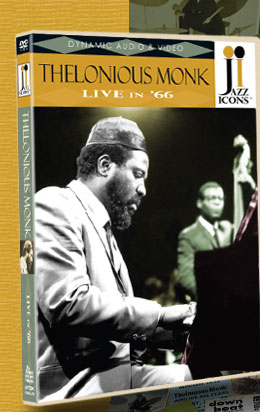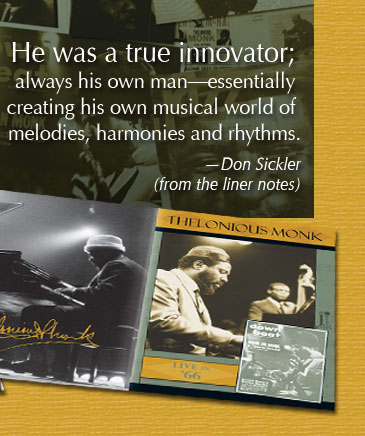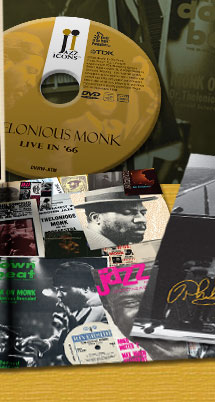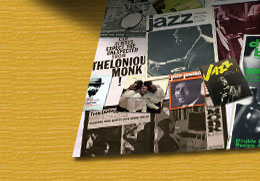




 |
 |
|
|||
|
|
|
||||
|
|
|
||||
|
|
|
||||
|
|
|
||||
 |
|
||||
 |
|
||||
 |
|
||||
|
|
|
|
|
|
|
 |
 |
 |
 |
Jazz Icons: Thelonious Monk features two intimate concerts filmed three days apart in Scandanavia in the Spring of 1966 with a legendary quartet that includes drummer Ben Riley, bassist Larry Gales and tenor saxophonist Charlie Rouse. Thelonious Monk revolutionized jazz with his innovative musical approach and these remarkable performances allow viewers the rare opportunity to experience Monk’s genius up close on his classic compositions “Blue Monk,” “Epistrophy” and “’Round Midnight.” |
|
 |
|
|
Piano- Thelonious Monk Tenor Sax- Charlie Rouse Bass- Larry Gales Drums- Ben Riley |
|
 |
|
|
Piano- Thelonious Monk Tenor Sax- Charlie Rouse Bass- Larry Gales Drums- Ben Riley |
|
20-page booklet Foreword by Monk's son T.S. Monk Liner notes by Don Sickler Cover photo by Lee Tanner Booklet photos by Herb Snitzer, Lee Tanner, Raymond Ross, Susanne Schapowalow, Riccardo Schwamenthal Memorabilia collage Total time: 62 minutes |
|
|
Foreword: THELONIOUS MONK - I never called the man that once in our life together. I always called him “Daddy.” That’s who he was to me, but his genius shined through, even in that capacity. My father, like any other artist, was pleased that I chose music as a career, but my getting in was going to be difficult—because of his reputation —and because of jealous fans. His plan was brilliant. He never mentioned music to me, really. ... Inspiration and humility are the keys to the kingdom of jazz. He wanted no artificial quests on my part to be him. He was interested in who I was. Just as he was interested in who Coltrane was; who Miles was; who Wilber Ware was and so on. To find myself, I had to be myself, and he and my mother, Nellie, made sure my sister Boo Boo and I had the chance to do just that. ... That is the genius of Thelonious Monk. Simplicity, directness and freedom to be yourself. So, I thank him as a fan, as a successful jazz musician who can always look to him for renewed inspiration and most of all I thank him for being such a wise and generous father. All my love to you, “Daddy.” T. S. Monk Sample Liner Notes by Don Sickler: Thelonious Monk has been a prominent voice in jazz since the early 1940s, when he could be heard in New York City playing at Minton’s Playhouse (where he was house pianist), Monroe’s Uptown House and other Harlem clubs. He played with the Lucky Millinder Orchestra in 1942 and made his first official recording date as part of the Coleman Hawkins quartet in October of 1944. He was dubbed “The High Priest of Bebop” in the late ’40s, creating an extremely fertile musical environment with Dizzy Gillespie, Charlie Parker, Bud Powell and the other beboppers. He was a true innovator; always his own man—essentially creating his own musical world of melodies, harmonies and rhythms. Tenor saxophonist Charlie Rouse was already established before he joined Monk. He played with the Billy Eckstine Orchestra in 1944 and the Dizzy Gillespie Big Band in 1945. He made recordings with Tadd Dameron and Fats Navarro in 1947, and played with Duke Ellington from May 1949 to March 1950. He recorded with Clifford Brown in 1953, and by the mid 1950s was appearing on recordings by various leaders. In 1956 he started recording with Les Jazz Modes (he was a co-leader, with French hornist Julius Watkins), a group that played together until 1959. He made his first appearance with the Thelonious Monk Quartet on September 30, 1958, as the group was starting the last two weeks of an extended stay at the Five Spot Café in NYC. Drummer Ben Riley caught everyone’s eye as a member of the Eddie “Lockjaw” Davis/Johnny Griffin two tenor sax quintet. His first recording with that group was in 1960. Riley continued to record with each of those leaders on their own individual recordings as well as with the dual sax group. In February 1962, Riley started recording with the piano-less quartet of Sonny Rollins (The Bridge album). Riley continued playing and recording with various groups throughout the next couple of years. He came to the attention of Thelonious Monk during Monk’s lengthy stay at the Five Spot Café starting in May 1963, and continuing until January 12, 1964. In those days, jazz clubs often had a double bill. Riley found himself playing six weeks opposite Monk, first in Walter Bishop Jr.’s trio, then in Bobby Timmons’ trio, and finally in Junior Mance’s trio. Monk never spoke to Riley, and Ben thought Monk had no idea who he was, until one night when Monk came up to him and said, “Who are you, the house drummer?” Riley got his first phone call from Monk near the end of that January, asking him to play on a recording session on January 29th. So Riley first played with Monk in the recording studio. He stayed with Monk until just before Christmas 1968. Bassist Larry Gales joined the Davis/Griffin quintet on Riley’s recommendation a couple of months after Riley made his first recording with that group. All of Gales’ next recordings, until November 1962, teamed him with Riley. In September of 1964, when Monk was looking for a bass player, Riley recommended Gales. The rest is history. Gales also remained with the Monk quartet until just before Christmas 1968. ... Lulu’s Back In Town- Monk plays the first half of the melody solo piano. Notice that he sets a faster tempo than the Oslo concert. Bass and drums enter at the bridge and the trio finishes the first chorus. Rouse enters and plays a whole melody chorus with the rhythm section. Remember the eight-measure A section background Monk played in the Oslo concert? Listen to the similarities and the differences here. When Rouse solos, Monk comps behind his first chorus, but doesn’t play behind the second and third choruses. Instead, he stands, walks around, and does his little dance (watch for his right elbow moves). Next, Monk solos for three choruses. Monk attacks the second chorus, and it sounds like he is going to play a third solo chorus, but then he starts to leave a lot of space and bassist Gales continues to “walk.” Notice Monk ends this solo, like he did in Oslo, with further variations of his eight-measure background theme, cueing the next soloist. Gales plays three solo choruses, and Monk gets up from the piano again. When Gales starts his second solo chorus, he restates the melody, and we see Monk walk up behind him and whisper something in his ear. Monk rarely said anything on stage, so it would be fascinating to know what he says here. Riley starts his three chorus solo with brushes, creatively switching to sticks in the second eight measures of his second chorus. The whole group re-enters after the drum solo, with Rouse soloing again until the bridge where he restates the melody. He solos for the rest of the chorus and one more complete chorus before restating the melody for the final chorus. This time he leaves the bridge open for Monk. All words and artwork on this page ©Reelin' In The Years Productions. Unauthorized use is prohibited.
|
|
Site contents ©Copyright 2006 Reelin' In The Years Productions
Site designed by Tom Gulotta